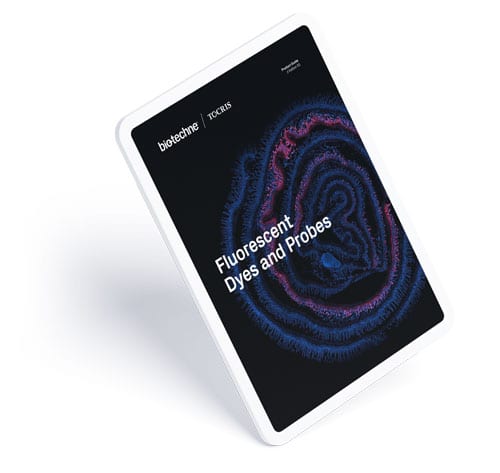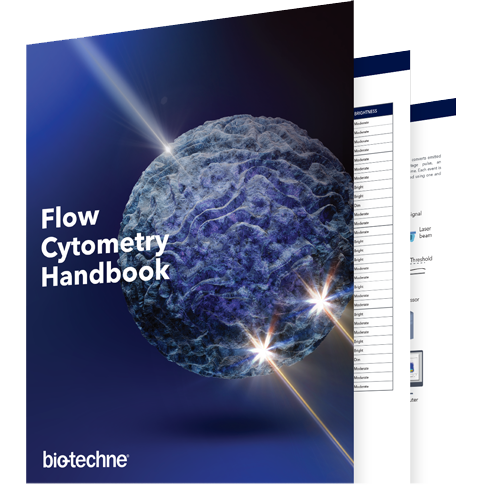Fluorescent Dyes
Our range of fluorescent dyes includes the Janelia Fluor® Dyes, which provide scientists with an exceptional palette of bright, photostable fluorophores for a broad range of applications, including super-resolution microscopy. The Janelia Fluor range includes products that possess different specific and useful properties, such as: fluorogenicity; spontaneous blinking (for facile single-molecule localization microscopy, SMLM); and photoactivation. Our Photoactivable Janelia Fluor® Dyes are particularly useful for Photoactivated Localization Microscopy (PALM) imaging. Also included in our portfolio are novel fluorophores in the near-infrared range, for deep tissue and in vivo imaging work. Together with a comprehensive palette of gold-standard dyes, we have products for all your imaging requirements.
Fluorescent dyes with a range of reactive handles are available to easily label various biomolecules. Common reactive groups include: succinimidyl esters (SE / NHS esters); maleimides; free acids; and click handle groups. Click handles include tetrazine, DBCO and azide handles to support copper-free, bioorthogonal click chemistry, and azide / alkyne handles to support copper-catalyzed click chemistry.
Protocols for fluorescent dyes conjugation are provided at Bio-Techne.
More information about Common Reactive Handles is provided below.
| Product Name | Reactive Group | Cat. No. | Excitation Wavelength (nm) | Emission Wavelength (nm) | Brightness | Emission Color |
|---|---|---|---|---|---|---|
| Ocean Blue | NHS ester | 6489 | 405 | 455 | 3 | Blue |
| BDY FL | NHS ester | 5465 | 502 | 510 | 4 | Green |
| FITC | Isothiocyanate | 5440 | 495 | 525 | 3 | Green |
| Janelia Fluor® 525 | NHS ester | 6296 | 525 | 549 | 5 | Yellow |
| HM Janelia Fluor® 526 | NHS ester | 7312 | 526 | 550 | - | Yellow |
| Janelia Fluor® 526 | NHS ester | 7316 | 526 | 550 | 5 | Yellow |
| PA Janelia Fluor® 549 | NHS ester | 6149 | 551-553 | 570-573 | - | Yellow |
| Janelia Fluor® 549 | Maleimide | 6500 | 549 | 571 | 5 | Yellow |
| Tetrazine | 6502 | 549 | 571 | 5 | Yellow | |
| NHS ester | 6147 | 549 | 571 | 5 | Yellow | |
| Free acid | 6503 | 549 | 571 | 5 | Yellow | |
| Janelia Fluor® 585 | NHS ester | 6418 | 585 | 609 | 5 | Orange/Red |
| Janelia Fluor® 635 | NHS ester | 6419 | 635 | 652 | 5 | Orange/Red |
| PA Janelia Fluor® 646 | NHS ester | 6150 | 649-651 | 663-665 | - | Orange/Red |
| Janelia Fluor® 646 | Maleimide | 6590 | 646 | 664 | 4 | Orange/Red |
| Free acid | 6993 | 646 | 664 | 4 | Orange/Red | |
| Azide | 7088 | 646 | 664 | 4 | Orange/Red | |
| Tetrazine | 7279 | 646 | 664 | 4 | Orange/Red | |
| NHS ester | 6148 | 646 | 664 | 4 | Orange/Red | |
| 5-TAMRA | NHS ester | 7665 | 546 | 580 | 3 | Orange/Red |
| Cyanine 5 | NHS ester | 5436 | 649 | 666 | 3 | Orange/Red |
| Janelia Fluor® 669 | NHS ester | 6420 | 669 | 682 | 3 | Far red |
| FNIR-Tag | NHS ester | 7373 | 765 | 788 | 4 | Near-IR |
| NIR Dye s775z | NHS ester | 7626 | 775 | 795 | 3 | Near-IR |
| Indocyanine green | - | 7510 | 787 | 815 | 3 | Near-IR |
| ICG-d7 | - | 7749 | 794 | 818 | 3 | Near-IR |
Janelia Fluor is a registered trademark of Howard Hughes Medical Institute.

Common Reactive Handles
Succinimidyl Esters (SE / NHS esters)
Succinimidyl Esters (SE / NHS esters)
NHS ester derivatives are suitable for modifying primary amines, which are prevalent on the surface of antibodies and other proteins due to the lysine side chain. Typically, NHS ester conjugation reactions are performed at slightly alkaline pH (pH=8-8.5).
Maleimides
Maleimides
Maleimides react with thiols (sulfhydryl groups), and so provide a convenient route to label cysteine-residues in proteins and peptides.
Free Acids
Free acid reactive groups are commonly used in the preparation of Halo- and SNAP-tag ligands via amide coupling reactions.
Click Handle groups
Click Chemistry refers to a class of chemical reactions that are modular, high yielding and simple to perform and purify. Click chemistry is therefore highly attractive as an approach for bioconjugation (attachment of a substrate of interest to a specific biomolecule), particularly site-specific bioconjugation. Highly related to the concept of click chemistry is ‘bioorthogonal chemistry’, which refers to reactions that can occur in biological environments without interfering with biochemical processes. The development of click chemistry and bioorthogonal chemistry was the subject of the 2022 Nobel Prize in Chemistry. The most common click chemistry reactions used for bioconjugation are summarized below:

The CuAAC reaction couples an alkyne with an azide (a [3+2] alkyne-azide cycloaddition) using copper as a catalyst, forming a stable 1,4-disubstituted 1,2,3-triazole-linked conjugate. Pros: the reaction is bioorthogonal, uses low molecular weight reactive handles, is highly selective, quick, quantitative and pH-insensitive. Cons: the cytotoxicity of the copper catalyst required for this reaction limits its use in living systems.

The SPAAC reaction is another azide-alkyne cycloaddition that avoids the use of copper, by incorporating the triple bond into a cyclooctyne. The cyclooctyne, DBCO (dibenzocyclooctyne, also known as DIBAC) is commonly used as a reactive handle for this reaction because it provides relatively rapid reaction kinetics and good stability in aqueous buffers. Pros: this reaction is copper-free and non-cytotoxic. Cons: it requires incorporation of relatively large cyclooctyne group.

The IEDDA reaction is the ultrafast cycloaddition between a strained double bond (commonly trans-cyclooctene) and a labeled tetrazine. Pros: the reaction is bioorthogonal, compatible with living systems, very rapid reaction kinetics, no catalyst required, ‘turn-on’ fluorescence of the tetrazine-functionalized dyes upon conjugation. Cons: it requires incorporation of two relatively large reactive handles.
Fluorescent Dyes and Probes Brochure
This product guide showcases our range and gives background on the use of Fluorescent Dyes and Probes.
Immunohistochemistry (IHC) Handbook
This recently updated handbook offers a comprehensive introduction to IHC.





